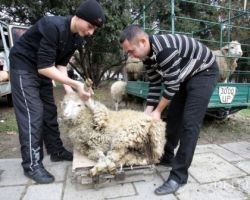On October 15 Muslims Celebrate Eid al-Adha

![]()
 It is a feast of sacrifice, which begins in the morning of the 10th day of Dhul-Hijjah of the Muslim lunar calendar and lasts four days. Eid al Adha is the culmination of the Hajj (pilgrimage to Mecca): pilgrims perform ritual sacrifices in the valley of Mina in commemoration of the sacrifice of Ibrahim (Abraham). Mention of this event is in the Bible and in the Koran.
It is a feast of sacrifice, which begins in the morning of the 10th day of Dhul-Hijjah of the Muslim lunar calendar and lasts four days. Eid al Adha is the culmination of the Hajj (pilgrimage to Mecca): pilgrims perform ritual sacrifices in the valley of Mina in commemoration of the sacrifice of Ibrahim (Abraham). Mention of this event is in the Bible and in the Koran.
Not only pilgrims but every Muslim who has the money is supposed to perform the sacrifice. Sacrificial animals are cows, sheep, and goats. The ceremony is performed after the holiday prayers, or sometime in the next two days of the holiday.
The meat of sacrificial animals is divided into three parts: one part is left for the person who performed the sacrifice, the second is distributed as alms to Muslims, and the third is given to relatives and neighbors, including non-Muslims. A good tradition is making from the third part festive dishes – pilaf, kebabs, manti – for neighbors, friends, relatives, and all who come to visit during the holidays.
The meaning of ritual sacrifice is primarily spiritual. Every Muslim using his hard-earned money has to sacrifice and share with the poor and needy, to treat his guests with a festive meal. This is an act of generosity and donation made with the hope of God's forgiveness.
Muslims of Ukraine on this day gather at holiday prayers, preach, share greetings, and visit Muslim cemeteries. There are charity fairs and holiday dinners.
It is during these days that Muslims, including Muslims in Ukraine, perform the pilgrimage (Hajj) to the holy places of Islam: Mecca and Medina. Hajj is a pillar of Islam and a ritual worship that must be performed at least once by every Muslim who has the ability and enough righteously earned money.









